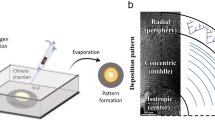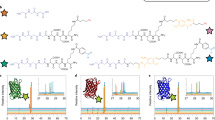Abstract
The interface between extracellular matrices and cells is a dynamic environment that is crucial for regulating important cellular processes such as signal transduction, growth, differentiation, motility and apoptosis1. In vitro cellular studies and the development of new biomaterials would benefit from matrices that allow reversible modulation of the cell adhesive signals at a scale that is commensurate with individual adhesion complexes. Here, we describe the fabrication of substrates containing arrays of cracks in which cell-adhesive proteins are selectively adsorbed. The widths of the cracks (120–3,200 nm) are similar in size to individual adhesion complexes (typically 500–3,000 nm)2 and can be modulated by adjusting the mechanical strain applied to the substrate. Morphology of cells can be reversibly manipulated multiple times through in situ adjustment of crack widths and hence the amount of the cell-adhesive proteins accessible to the cell. These substrates provide a new tool for assessing cellular responses associated with exposure to matrix proteins.
This is a preview of subscription content, access via your institution
Access options
Subscribe to this journal
Receive 12 print issues and online access
$259.00 per year
only $21.58 per issue
Buy this article
- Purchase on Springer Link
- Instant access to full article PDF
Prices may be subject to local taxes which are calculated during checkout



Similar content being viewed by others
References
Giancotti, F. G. & Ruoslahti, E. Integrin signaling. Science 285, 1028–1032 (1999).
Cukierman, E., Pankov, R., Stevens, D. & Yamada, K. M. Taking cell-matrix adhesions to the third dimension. Science 294, 1708–1712 (2001).
Dike, L. E. et al. Geometric control of switching between growth, apoptosis, and differentiation during angiogenesis using micropatterned substrates. In Vitro Cell. Dev. An. 35, 441–448 (1999).
Maheshwari, G., Brown, G., Lauffenburger, D. A., Wells, A. & Griffity, L. G. Cell adhesion and motility depend on nanoscale RGD clustering. J. Cell Sci. 113, 1677–1686 (2000).
Arnold, M. et al. Activation of integrin function by nanopatterned adhesive interfaces. Chem. Phys. Chem. 5, 383–388 (2004).
Chen, C. S., Mrksich, M., Huang, S., Whitesides, G. M. & Ingber, D. E. Geometric control of cell life and death. Science 276, 1425–1428 (1997).
Smilenov, L. B., Mikhailov, A., Pelham, R. J. Jr, Marcantonio, E. E. & Gundersen, G. G. Focal adhesion motility revealed in stationary fibroblasts. Science 286, 1172–1174 (1999).
Okano, T., Yamata, N., Sakai, J. & Sakurai, Y. Mechanism of cell detachment from temperature-modulated, hydrophilic-hydrophobic polymer surfaces. Biomaterials 16, 297–303 (1995).
Elbert, D. L. & Hubbell, J. A. Conjugate Addition reactions combined with free-radical cross-linking for the design of materials for tissue engineering. Biomacromolecules 2, 430–441 (2001).
Schutt, M. et al. Photocontrol of cell adhesion processes: model studies with cyclic azobenzene-RGD peptides. Chem. Biol. 10, 487–490 (2003).
Yeo, W.-S., Yousaf, M. N. & Mrksich, M. Dynamic interfaces between cells and surfaces: electroactive substrates that sequentially release and attach cells. J. Am. Chem. Soc. 125, 14994–14995 (2003).
Jiang, X. Y., Ferrigno, R., Mrksich, M. & Whitesides, G. M. Electrochemical desorption of self-assembled monolayers noninvasively releases patterned cells from geometrical confinements. J. Am. Chem. Soc. 125, 2366–2367 (2003).
Bowden, N., Huck, W. T. S., Paul, K. E. & Whitesides, G. M. The controlled formation of ordered, sinusoidal structures by plasma oxidation of an elastomeric polymer. Appl. Phys. Lett. 75, 2557–2559 (1999).
Ruardij, T. G., van den Boogaart, M. A. F. & Rutten, W. L. C. Adhesion and growth of electrically active cortical neurons on polyethylenimine patterns microprinted onto PEO-PPO-PEO triblockcopolymer-coated hydrophobics surfaces. IEEE Trans. Nanobiosci. 1, 4–11 (2002).
Nelson, C. M., Raghavan, S., Tan, J. L. & Chen, C. S. Degradation of micropatterned surfaces by cell-dependent and -independent processes. Langmuir 19, 1493–1499 (2003).
Thouless, M. D. Crack spacing in brittle films on elastic substrates. J. Am. Ceram. Soc. 73, 2144–2146 (1990).
Thouless, M. D., Olsson, E. & Gupta, A. Cracking of brittle films on an elastic substrate. Acta Metall. Mater. 40, 1287–1292 (1992).
Hutchinson, J. W. & Suo, Z. Mixed-mode cracking in layered materials. Adv. Appl. Mech. 29, 64–187 (1992).
Beuth, J. L. Cracking of thin bonded films in residual tension. Int. J. Solid Struct. 29, 1657–1675 (1992).
Huang, R., Prevost, J. H., Huang, Z. Y. & Suo, Z. Channel-cracking of thin films with the extended finite-element method. Eng. Fract. Mech. 70, 2513–2526 (2003).
Shenoy, V. B., Schwartzman, A. F. & Freund, L. B. Crack patterns in brittle thin films. Int. J. Fract. 103, 1–17 (2000).
Clark, P., Dunn, G. A., Knibbs, A. & Peckham, M. Alignment of myoblasts on ultrafine gratings inhibits fusion in vitro. Int. J. Biochem. Cell Biol. 34, 816–825 (2002).
Berendse, M., Grounds, M. D. & Lloyd, C. Myoblast structure affects subsequent skeletal myotube morphology and sarcomere assembly. Exp. Cell Res. 291, 435–450 (2003).
Clarkson, E. D., Edwards-Prasad, J., Freed, C. R. & Prasad, K. N. Immortalized dopamine neurons: a model to study neurotoxicity and neuroprotection. Proc. Soc. Exp. Biol. Med. 222, 157–163 (1999).
Easter, S. S., Purves, D., Rakie, P. & Spitzer, N. C. The changing view of neural specificity. Science 230, 507–511 (1985).
Geissler, M. & Xia, Y. N. Patterning: Principles and some new developments. Adv. Mater. 16, 1249–1269 (2004).
Lee, K. B., Park, S. J., Mirkin, C. A., Smith, J. C. & Mrksich, M. Protein nanoarrays generated by dip-pen nanolithography. Science 295, 1702–1705 (2002).
Mrksich, M. What can surface chemistry do for cell biology? Curr. Opin. Chem. Biol. 6, 794–797 (2002).
Geho, D. H., Lahar, N., Ferrari, M., Petricoin, E. F. & Liotta, L. A. Opportunities for nanotechnology-based innovation in tissue proteomics. Biomed. Microdevices 6, 231–239 (2004).
Scheibel, T. et al. Conducting nanowires built by controlled self-assembly of amyloid fibers and selective metal deposition. Proc. Natl Acad. Sci. USA 100, 4527–4532 (2003).
Acknowledgements
We thank J. F. Mansfield and C. Wauchope for AFM assistance, S.-H. Chiang for the C2C12 cells, C. Chen for helpful discussions, D. P. Brereton for reviewing the article, BASF Corporation for kindly providing the PLURONIC F108 surfactant, and NIH (EB003793-01, PO1 AG20591), NSF (BES-0238625; DMI-0403603; CTS-0116331) and the NASA BioScience and Engineering Institute (NNC04AA21A) for funding.
Author information
Authors and Affiliations
Corresponding author
Ethics declarations
Competing interests
K.N. is co-founder of Strex. The other authors have no competing financial interests.
Supplementary information
Supplementary Information
Supplementary information and figures 1, 2, 3, 4 and 5 (PDF 605 kb)
Rights and permissions
About this article
Cite this article
Zhu, X., Mills, K., Peters, P. et al. Fabrication of reconfigurable protein matrices by cracking. Nature Mater 4, 403–406 (2005). https://doi.org/10.1038/nmat1365
Received:
Accepted:
Published:
Issue Date:
DOI: https://doi.org/10.1038/nmat1365
This article is cited by
-
Fabrication of Grid-Type Transparent Conducting Electrodes Based on Controlled Mechanical Fracture
Macromolecular Research (2018)
-
Epitaxial growth and cracking of highly tough 7YSZ splats by thermal spray technology
Journal of Advanced Ceramics (2018)
-
Anomalous Epitaxial Growth in Thermally Sprayed YSZ and LZ Splats
Journal of Thermal Spray Technology (2017)
-
Formation of Lamellar Pores for Splats via Interfacial or Sub-interfacial Delamination at Chemically Bonded Region
Journal of Thermal Spray Technology (2017)
-
Manual, In situ, Real-Time Nanofabrication using Cracking through Indentation
Scientific Reports (2016)



